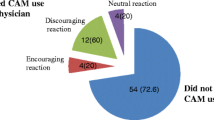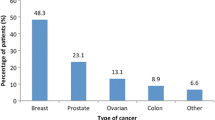Abstract
The purpose of this study was to examine the prevalence and predictors of complementary and alternative medicine (CAM) use among rural patients with localized prostate cancer. The study also examined the participants’ disclosure of CAM use to their physicians. Baseline and 6-month follow-up data were taken from a study examining the factors that influence treatment choice and quality of life among men diagnosed with and being treated for localized prostate cancer residing in rural southwest Georgia (N = 321). A total of 291 participants were interviewed at baseline and 6-month follow-up. Findings: At baseline, 26.4% reported ever using CAM. Among them, dietary supplements were the most commonly used (75%), and 56% of patients did not disclose their CAM use to their physicians. At 6-month follow-up, 11% of the study sample reported using CAM since starting treatment (half of these were new users). The proportions of CAM users who reported taking dietary supplements after treatment were significantly lower than the corresponding proportions before treatment. CAM use after treatment was more common among those who selected surgery and watchful waiting. While 44% of the sample disclosed using CAM to their doctors before treatment, 61% after treatment began (P = 0.05). We found that CAM use after cancer treatment in this population was markedly less common than in nationally reported data for cancer patients. In line with national patterns, younger and more educated rural patients were significantly more likely to have ever used CAM and to use it after treatment.
Similar content being viewed by others
References
Eisenberg, D. M., Davis, R. B., Ettner, S. L., et al. (1998). Trends in alternative medicine use in the United States, 1990–1997: results of a follow-up national survey. Journal of American Medical Association, 280(18), 1569–1575.
Eisenberg, D. M., Kessler, R. C., Foster, C., Norlock, F. E., Calkins, D. R., & Delbanco, T. L. (1993). Unconventional medicine in the United States. Prevalence, costs, and patterns of use. New England Journal of Medicine, 328(4), 246–252.
Astin, J. A. (1998). Why patients use alternative medicine: Results of a national study. Journal of American Medical Association, 279(19), 1548–1553.
Barnes, P., Powell-Griner, E., McFann, K., & Nahin, R. (2002) CDC Advance Data Report #343. Complementary and alternative medicine use among adults: United States.
Richardson, M. A., Sanders, T., Greisinger, A., & Singletary, S. E. (2000). Complementary/alternative medicine use in a comprehensive cancer center and the implications for oncology. Journal of Clinical Oncology, 18(13), 2505–2514.
Ni, H., Simile, C., & Hardy, A. M. (2002). Utilization of complementary and alternative medicine by United States adults: results from the 1999 national health interview survey. Medical Care, 40(4), 353–358.
Standish, L. J., Greene, K. B., Bain, S., et al. (2001). Alternative medicine use in HIV-positive men and women: demographics, utilization patterns and health status. AIDS Care, 13(2), 197–208.
Bausell, R. B., Lee, W. L., & Berman, B. M. (2001). Demographic and health-related correlates to visits to complementary and alternative medical providers. Medical Care, 39(2), 190–196.
Percentages of adults aged 18 and over who use complementary and alternative medicine (CAM), by selected diseases and conditions and sex—National Health Interview Survey, United States, 2007. Morbidity and Mortality Weekly Report, 2008; 57(35), 971.
Robinson, A., & McGrail, M. R. (2004). Disclosure of CAM use to medical practitioners: a review of qualitative and quantitative studies. Complement Therapies in Medicine, 12, 90–98.
Lippert, M., McClain, R., Boyd, J., & Theodorescu, D. (1999). Alternative medicine use in patients with localized prostate carcinoma treated with curative intent. Cancer, 86(12), 2642–2648.
Kao, G., & Devine, P. (2000). Use of complementary health practices by prostate carcinoma patients undergoing radiation therapy. Cancer, 88(3), 615–619.
Zhang, Y., Jones, B., Ragain, M., Spalding, M., Mannschreck, D., & Young, R. (2008). Complementary and alternative medicine use among primary care patients in west Texas. Southern Medical Journal, 101(12), 1232–1237.
Wilkinson, S., Gomella, L., Smith, J., et al. (2002). Attitudes and use of complementary medicine in men with prostate cancer. Journal of Urology, 168(6), 2505–2509.
Tindle, H. A., Davis, R. B., Phillips, R. S., & Eisenberg, D. M. (2005). Trends in use of complementary and alternative medicine by US adults: 1997–2002. Alternative Therapies in Health and Medicine, 11(1), 42–49.
Shreffler-Grant, J., Hill, W., Weinert, C., Nichols, E., & Ide, B. (2007). Complementary therapy and older rural women: Who uses it and who does not? Nursing Research, 56(1), 28–33.
Herron, M., & Glasser, M. (2003). Use of and attitudes toward complementary and alternative medicine among family practice patients in small rural Illinois communities. Journal of Rural Health, 19(3), 279–284.
Diefenbach, M., Hamrick, N., Uzzo, R., et al. (2003). Clinical, demographic and psychosocial correlates of complementary and alternative medicine use by men diagnosed with localized prostate cancer. Journal of Urology, 170(1), 166–169.
Paramore, L. C. (1997). Use of alternative therapies: estimates from the 1994 Robert Wood Johnson Foundation National Access to Care Survey. Journal of Pain and Symptom Management, 13(2), 83–89.
Cuellar, N., Aycock, T., Cahill, B., & Ford, J. (2003). Complementary and alternative medicine (CAM) use by African American (AA) and Caucasian American (CA) older adults in a rural setting: a descriptive, comparative study. BMC Complementary and Alternative Medicine, 3, 8.
Friedell, G., Linvile, L., & Hullet, S. (1998). Cancer control in rural Appalachia. Cancer, 83(9), 1868–1871.
Nguyen, T., & Whetten, K. (2003). Is anybody out there? Public Health Reports, 118(1), 3–9.
Burstein, H. J. (2000). Discussing complementary therapies with cancer patients: What should we be talking about? Journal of Clinical Oncology, 18(13), 2501–2504.
Ponholzer, A., Struhal, G., & Madersbacher, S. (2003). Frequent use of complementary medicine by prostate cancer patients. European Urology, 43(6), 604–608.
American Cancer Society. (2009). Cancer Facts & Figures 2009. Atlanta: American Cancer Society.
Chan, J. M., Elkin, E. P., Silva, S. J., Broering, J. M., Latini, D. M., & Carroll, P. R. (2005). Total and specific complementary and alternative medicine use in a large cohort of men with prostate cancer. Urology, 66(6), 1223–1228.
Oh, W. K., & Small, E. J. (2002). Complementary and alternative therapies in prostate cancer. Seminars in Oncology, 29(6), 575–584.
Beebe-Dimmer, J. L., Wood, D. P, Jr., Gruber, S. B., et al. (2004). Use of complementary and alternative medicine in men with family history of prostate cancer: A pilot study. Urology, 63(2), 282–287.
Boon, H., Westlake, K., Stewart, M., et al. (2003). Use of complementary/alternative medicine by men diagnosed with prostate cancer: Prevalence and characteristics. Urology, 62(5), 849–853.
Eng, J., Ramsum, D., Verhoef, M., Guns, E., Davison, J., & Gallagher, R. (2003). A population-based survey of complementary and alternative medicine use in men recently diagnosed with prostate cancer. Integrative Cancer Therapies, 2(3), 212–216.
Patterson, R. E., Neuhouser, M. L., Hedderson, M. M., et al. (2002). Types of alternative medicine used by patients with breast, colon, or prostate cancer: predictors, motives, and costs. Journal of Alternative and Complementary Medicine, 8(4), 477–485.
Jones, R. A., Taylor, A. G., Bourguignon, C., et al. (2007). Complementary and alternative medicine modality use and beliefs among African American prostate cancer survivors. Oncology Nursing Forum, 34(2), 359–364.
Milden, S. P., & Stokols, D. (2004). Physicians’ attitudes and practices regarding complementary and alternative medicine. Behavioral Medicine, 30(2), 73–82.
Giveon, S. M., Liberman, N., Klang, S., & Kahan, E. (2003). A survey of primary care physicians’ perceptions of their patients’ use of complementary medicine. Complementary Therapies in Medicine, 11(4), 254–260.
Winslow, L. C., & Shapiro, H. (2002). Physicians want education about complementary and alternative medicine to enhance communication with their patients. Archives of Internal Medicine, 162, 1176–1181.
Acknowledgments
This publication was supported by Cooperative Agreement Number SIP 25-04 (Grant 3 U48 DP000043-01S1) from the Centers for Disease Control and Prevention. The findings and conclusions in this report are those of the authors and do not necessarily represent the official position of the Centers for Disease Control and Prevention.
Author information
Authors and Affiliations
Corresponding author
Rights and permissions
About this article
Cite this article
Butler, S., Owen-Smith, A., DiIorio, C. et al. Use of Complementary and Alternative Medicine Among Men with Prostate Cancer in a Rural Setting. J Community Health 36, 1004–1010 (2011). https://doi.org/10.1007/s10900-011-9402-6
Published:
Issue Date:
DOI: https://doi.org/10.1007/s10900-011-9402-6




